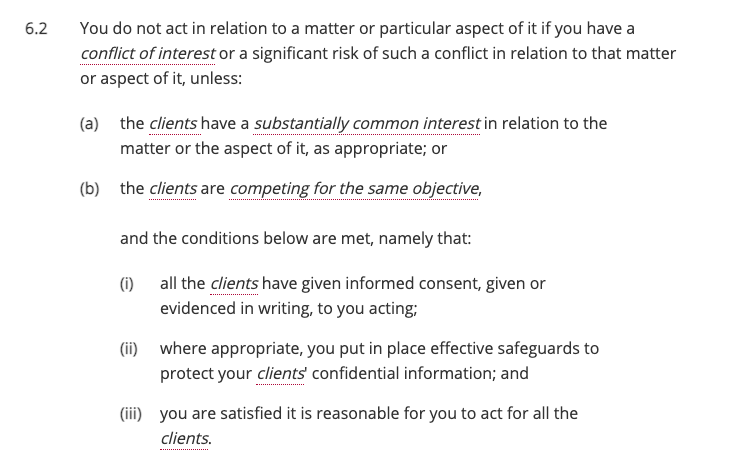It’s often best to think about compliance issues in simple terms. Solicitors conflicts of interests is no different. If you go back to the first principles, regardless of what the Codes of Conduct and reams of guidance say, you should be in a good position to come to a view on whether you can or can’t act.
Principle 7 says you have to act in the interests of each client. That is not new. It is a fundamental part of being a lawyer.
So essentially, what you are doing when weighing up the potential for a conflict is asking yourself:
- “Is there any reason why I can’t act in each of my clients’ best interests?”
- “If I do this for client A, will it be detrimental to client B?”
- “Would my advice be any different if I only acted for one of these clients?”
- “Am I able to act in my client’s best interest if I also have an interest in this somehow?”
Going back to basics often means you don’t have to get into the weeds of the rulebook.
After all, we are told that the point of principles based regulation is a focus on professional judgment, not prescriptive rules.
However, the Codes of Conduct do contain strict rules around conflict of interests. Essentially:
- You must not act if there is an own interest conflict (i.e. your own interests are in conflict with your client’s) or a significant risk of such a conflict
- You must not act if you have a conflict of interest (where two or more clients’ interests are not aligned, formerly known as a client conflict) or a significant risk of such a conflict – unless the exceptions apply.
What are the exceptions to the conflict rules?
First, it’s important to remember that we can never act in an own interest conflict situation. No exemptions apply. It is an absolute no-no and will end in disciplinary sanction if the SRA finds out about it.
If you find yourself in a more favourable position at the expense of your client, that’s a tell tale sign of an own interest conflict.
Don’t do it. Walk away. Refer them somewhere else. Be upfront about it, there’s no need to be embarrassed. One of the really great things about being regulated is that you can blame the regulators when you need to have an awkward conversation with the client.
So when talking about exceptions to the conflict rules, we are only referring to client conflicts (confusingly now just called a ‘conflict of interest’).
Paragraph 6.2 of the Code of Conduct for Solicitors – which is mirrored in Paragraph 6.2 of the Code of Conduct for Firms – says that there are two exceptions:
- the ‘substantially common interest’ exception and
- the ‘competing for the same objective’ exception.
Both exceptions are subject to three conditions.
In the vast majority of cases, it is the substantially common interest exception that applies.
Competing for the same objective
Where you have two commercial clients who are in a tender or auction or some other competitive process (i.e. there can only be one winner), obviously their interests are not aligned.
But the lawyer has very little control over the outcome of that process. The legal advice you give is likely to be irrelevant to whether either party succeeds in the competition. That will be decided by someone else, for example a procurement team, auctioneer, or insolvency practitioner.
It would make little sense for there to be a blanket ban on acting for more than one client in these circumstances, although you still need to take care that you can in fact act in each client’s best interests. We’ll come onto the conditions attached to this exception below.
Substantially common interest
This is a very broad exception to the general prohibition on acting in a client conflict situation. It can cover a wide range of scenarios and it is ultimately down to you and your professional judgment to decide when it applies.
The SRA guidance says that the substantially common interest exception arises “where there is a clear common purpose between the clients and a strong consensus on how that purpose is to be achieved.”
They give the examples of “two clients wanting to instruct you to advise them on the purchase or setting up of a business together, or taking out a lease as joint tenants.”
The all-important conditions
To rely on either of the exceptions, you have to satisfy three conditions:
- all the clients must have given informed consent to you acting, given or evidenced in writing
- where appropriate, you must have put in place effective safeguards to protect your clients’ confidential information, and
- you must be satisfied it is reasonable for you to act for all the clients
1. Informed consent
Unhelpfully, this isn’t defined in the rulebook but you can use your common sense. It will depend on the facts of the individual case in front of you.
It suggests that you will have to clearly explain the conflict situation so that the client understands the position.
You will almost certainly have to take more steps to ensure consent is informed from a private or vulnerable client versus a sophisticated commercial client. And it has to be in writing.
2. Effective safeguards
The second condition refers to having effective safeguards to protect confidential information where that is appropriate.
Just because your clients consent to you acting in the conflict situation, that does not absolve you of your duty to protect their confidential information.
You do not have carte blanche to tell client A about client B’s affairs and vice versa. (Although, if that is likely to be helpful in the transaction, you might also consider asking if the clients would consent to that – clients can always waive their own confidentiality.)
If you do not have the clients’ authority to disclose confidential information, you might consider other safeguards such as using different lawyers within the same firm, perhaps an entirely different office, restricting information on electronic files and other information barriers. These are sometimes called ‘ethical walls’ and used to be called ‘Chinese walls’.
Don’t forget that keeping client A in the dark about client B’s confidential information (if relevant to client A’s matter) can cause a whole other issue.
You have a competing duty to disclose all information material to your client’s case of which you have knowledge (Paragraph 6.4 of the Code of Conduct). There are exceptions, including informed consent given in writing.
The confidentiality v disclosure conundrum has flummoxed many a well-meaning lawyer.
3. Reasonableness
Are you satisfied that it’s reasonable for you to act for all the clients? This comes back to professional judgement.
The SRA guidance gives the following examples to test reasonableness:
- unequal position of power
- substantial negotiations necessary between the clients
- whether there are advantages to the clients in having one lawyer
- risks of accidental transfer of confidential information
This is perhaps also another of those opportunities to pan out and take a bird’s eye view of the situation. You might ask yourself, “am I being reasonable in continuing to act, or am I just reacting to pressure from my clients or even the firm?”.
Access to a more objective second pair of eyes is also likely to help. In smaller firms, the COLP should be directly involved in any decision to act in a conflict situation. For larger firms, the case might be referred to a conflict committee.
Yes, the conditions apply to both exceptions
There is some pretty poor drafting in the rulebook, but this one is particularly misleading:

You’ll see that paragraph 6.2 (which deals with the conditions you have to comply with in order to act in one of the two exceptions), on the face of it only attach to the second exception, competing for the same objective.
Actually, those Roman numerals i, ii, iii are supposed to be attached to both exceptions – substantially common interest and competing for the same objective.
It is worth pointing out because it’s not clear by just reading the rule.
Unbundling, and the use of restricted retainers to manage solicitors conflicts of interests
Although it is not covered in the rulebook, the SRA’s separate guidance suggests there is another way to avoid a client conflict situation, by using ‘restricted’ or ‘limited’ retainers.
This is where you carefully and accurately scope out what is and is not included in your services, for example advice on a particular part of a transaction. This is sometimes call ‘unbundling’. It means that you can effectively agree with the clients that you will not advise either of them on the bits that would otherwise cause you a conflict of interests.
That might be easier said than done.
Everyone would have to agree to a limited retainer, which means them fully understanding why you are restricting your advice and what the legal advice gaps will be.
You’re always going to satisfy the best interests of clients point, too. If you are restricting your retainer to keep both clients but it is not in your client’s best interests to do so, you are heading for problems.
And you can’t just turn a blind eye to serious risks that may prejudice a client, just because it falls outside the scope of the limited retainer. The SRA has sanctioned solicitors for ignoring obvious risks to investor clients (relating to investment schemes or buying property off plan) where the solicitor was acting for the developer.
Tellingly, the guidance says that the SRA would expect that a limited retainer should be suggested by the client and not the solicitor.
That’s regulator code for do this at your own risk.
How to manage conflicts of interest risk
Acting with a conflict in play is inherently risky and shouldn’t be engaged in lightly.
A single person making the decision whether to act or not could easily make the wrong call. Either because they just don’t see the conflict as a big deal or they are blinded by their motive to keep the clients happy (or perhaps maximise their billing).
No, deciding to act in a potential conflict situation needs careful consideration. In most cases the decision should be signed off by a senior manager, partner or the COLP.
Most firms already have conflicts policies that set out the steps that file handlers need to take when a conflict arises. From experience, these policies are often followed inconsistently in practice. Given their importance (regulatory action if we get it wrong), there needs to be an element of oversight and testing of those processes.
In most smaller firms the COLP should be directly involved in all conflict issues, and in larger firms there should be some other formal mechanism.
If the decision is made to continue to act, then your usual risk management systems should kick in. Every firm has different systems, but a sensible risk management system might look something like this:
- Solicitor refers a potential conflict to the COLP or conflict committee
- COLP or committee makes a decision on (a) whether instructions can be taken and (b) any necessary steps to manage the conflict (such as putting in place information barriers and getting informed consent).
- This is documented on the file and the firm’s risk register.
- COLP or committee then keeps an eye on the file until it is complete, asking for regular updates from the file handler.
- Is there any change in the assessment of risk?
- Has the nature of the conflict changed as the matter has progressed?
- Risk removed from the register when the matter completes.








